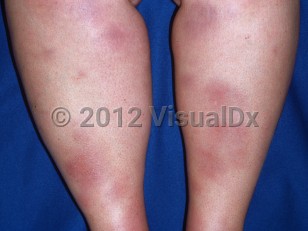Erythema nodosum in Adult
Alerts and Notices
Important News & Links
Synopsis

Associated bacterial, viral, fungal, and protozoal infections are numerous and include Streptococcus, Shigella, Yersinia, Histoplasma, Coccidioides, HIV, Giardia, and COVID-19. Tuberculosis (TB) remains an important cause in areas of endemic disease. Less commonly, Campylobacter, Salmonella, cat-scratch disease, Chlamydia, syphilis, pertussis, leprosy, hepatitis B, blastomycosis, and sporotrichosis may be precipitants. Inflammatory associations include sarcoidosis, inflammatory bowel disease, Sjögren syndrome, reactive arthritis, and Behçet disease. In Crohn disease, EN may occur even if the Crohn disease is well controlled. Malignancy, such as lymphoma or leukemia, is a rare cause of EN.
The eruption typically persists for 3-6 weeks and spontaneously regresses without scarring or atrophy. Recurrences are sometimes seen, especially with reoccurrence of the precipitating factor(s).
Arthralgias, often in the ankles and knees, are reported by a majority of patients, regardless of the etiology of EN.
No specific genetic predilection exists except for in relation to the underlying diseases (eg, sarcoidosis is more common in Black individuals). EN can occur at any age, but most cases occur between the ages of 20 and 45, particularly in women. Sex incidence before puberty is about equal.
Löfgren syndrome is a benign variant of sarcoidosis with EN and bilateral enlargement of the hilar lymph nodes. It occurs more commonly in females, especially during pregnancy.
Subacute nodular migratory panniculitis is a variant of EN. It is often unilateral, more focal, and painless. Gradual expansion is characteristic.
Codes
L52 – Erythema nodosum
SNOMEDCT:
32861005 – Erythema nodosum
Look For
Subscription Required
Diagnostic Pearls
Subscription Required
Differential Diagnosis & Pitfalls

Subscription Required
Best Tests
Subscription Required
Management Pearls
Subscription Required
Therapy
Subscription Required
Drug Reaction Data
Subscription Required
References
Subscription Required
Last Updated:07/02/2022
 Patient Information for Erythema nodosum in Adult
Patient Information for Erythema nodosum in Adult- Improve treatment compliance
- Reduce after-hours questions
- Increase patient engagement and satisfaction
- Written in clear, easy-to-understand language. No confusing jargon.
- Available in English and Spanish
- Print out or email directly to your patient


